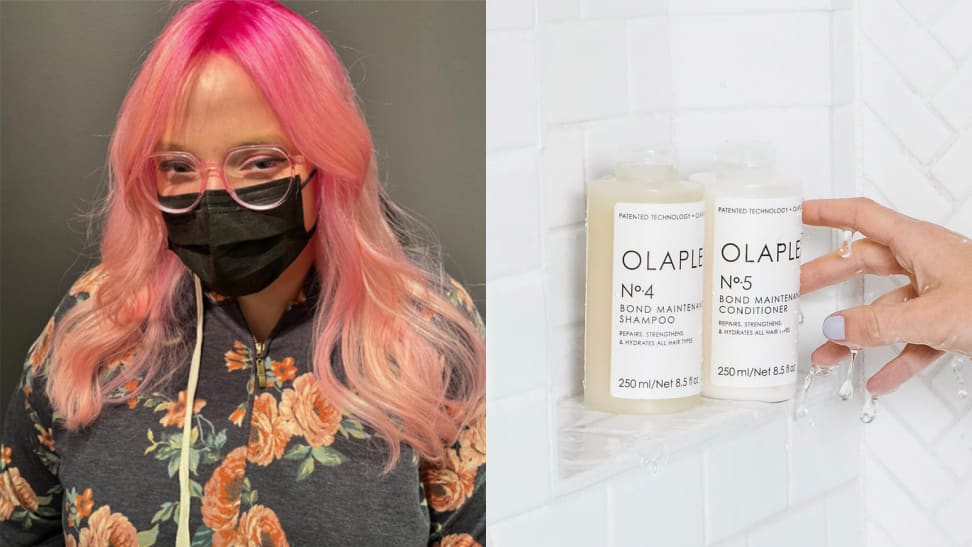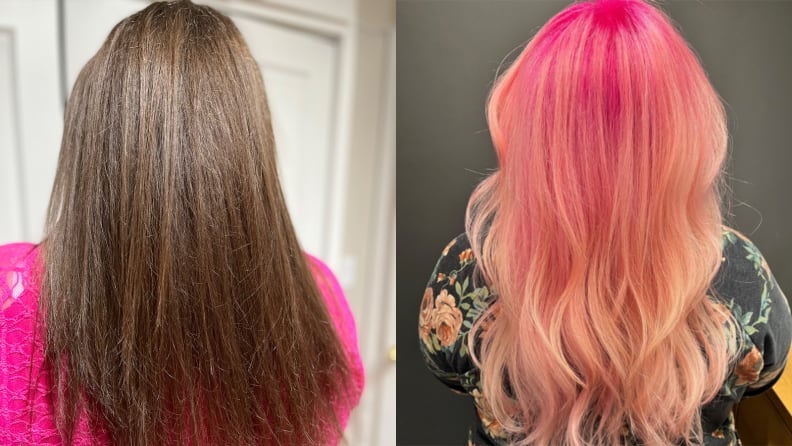I dyed my hair pastel pink—here's how I take care of it
Plus tips and product recommendations from stylists
 Credit:
Reviewed / Casey Clark / Olaplex
Credit:
Reviewed / Casey Clark / Olaplex
Products are chosen independently by our editors. Purchases made through our links may earn us a commission.
The thought of dyeing my naturally honey blond hair pastel lingered in the back of my mind for five years. Picture cotton candy, mermaid, and unicorn-inspired bright tones—that’s what I was after. To me, pastel hair meant my light-hearted personality would come across at first glance without having to say a word. I’d look creative, fun, and even trendy. However, I worried that bleaching my base color enough for a pastel hue did not seem feasible. I also felt nervous about damaging my hair, maintaining the color post-dye, and even whether I’d love the results as much as I hoped I would.
Despite my doubts, I took the leap to get the hair of my dreams. I visited the Fekkai Soho in New York City where I met Krystel Cuadra, who gave me the ultimate hair transformation. Cuadra is a colorist at the salon who has been working with hair for over a decade—she knows a thing or two about how to deliver on complex asks, like turning dark blond locks into an ombréd 'do that cascades from vibrant to pastel pink. Given my nerves going into it, I asked Cuadra all of my questions about the process of going pastel and caring for it once you leave the salon.
What it’s like to dye your hair pastel

My hair before (left) and after (right) dyeing it pastel pink.
A word of advice: Do not bleach your hair at home and do not use boxed dye. If you care about the health and integrity of your strands, leave it to the professionals.
Unless you have naturally light blond hair, your dye job will most likely require bleach. There’s no getting around the fact that bleach is damaging to hair, but stylists are equipped with the skills to safely lighten and dye your hair with as minimal damage as possible, making the salon trip worth it.
“If you have dark, color-treated hair, chances are that pastel hair will not be achievable for you [because], in order for the pastel color to be visible, hair needs to be lifted to almost light yellow [or] white,” Cuadra says. “Clients with virgin hair are able to go lighter than color-treated clients and the process would involve a global lightening service (sometimes two rounds) to get hair to a light enough point to then deposit the color.”
The process itself typically takes between six to eight hours depending on how dark your hair is, how quickly the bleach lightens it (undyed hair lifts faster), and how much hair you have. Plan for an entire day in the salon and pack some headphones and magazines with you to help the time pass.
Once out of the salon, you’ll need to switch up your routine to maintain the color’s vibrancy. For tips on how to do so, I reached out to some of NYC’s top hairstylists to learn their tips for taking care of pastel hair—plus products to help you along the way.
1. Wash with a color-safe shampoo

Use a color-safe shampoo like the Olaplex Nº.4 Bond Maintenance Shampoo to maintain color.
All of the stylists I spoke with recommend that you refrain from washing your hair for two to three days after it’s dyed to give the cuticle layer time to close and trap the color molecule—a process necessary for the color to last in the hair.
When it’s time for a wash, you’ll want to invest in some good quality, color-safe shampoo to prolong your results—especially after spending a few hundred dollars on your new look. Color-safe shampoos are typically free from sulfates, or cleansing agents responsible for lathering, and contain more conditioning ingredients, antioxidants, proteins and amino acids designed specifically to treat processed hair.
When looking for a color-safe shampoo, Cuadra recommends what her salon uses: Fekkai’s Color Technician Shampoo, that claims to prevent fading with mirabelle plum seed oil and protect hair from sun damage with plant-derived extracts. Another option that I use on my own hair is Olaplex’s Nº.4 Bond Maintenance Shampoo, which claims to repair damaged hair to improve shine and smoothness with a chemical called bis-aminopropyl diglycol dimaleate that’s supposed to bond broken strands together.
2. Keep your water temperature cool
There’s nothing like a warm shower after a long day, but if you can brave a cold rinse, consider turning the temperature down for the sake of your pastel hair, suggests Brittany Rodriguez, hair colorist at Medusa Salon in Brooklyn, New York. In the most simple terms, warm water causes the hair cuticle to open up and allows the color molecules to escape.
“Because [pastels] are so light in color, the pigment of the color is not as strong to hold onto,” says Tonianne Avolio, stylist at A Touch Of Tone Studio in Staten Island. This means that it’s harder to stop pastels from fading from the hair and, as a result, maintenance may require frequent salon trips unless you’re diligent about rinsing out that color-safe shampoo (and conditioner) in cool water.
3. Skip washing your hair every day

Spritz the Dove Refresh + Care Dry Shampoo into your hair in between washes for freshness.
Washing your hair daily strips hair of its natural oils and causes the color to fade quicker. Even if you rinse your hair with cold water, you’ll lose some dye with each wash. To prevent this, try shampooing two or three times per week, even if you need to begin weaning yourself off of daily sudsing in the weeks before coloring your hair.
To help you get through the process, lean on Reviewed’s best dry shampoo pick, the Dove Refresh + Care Dry Shampoo. It leaves the hair feeling clean with zero powdery residue, regardless of your hair color or type.
4. Add a conditioning treatment

Condition your hair using the Fekkai Shea Butter Intense Mask.
After your hair is treated with bleach, it will most likely feel more dry and brittle than before. A conditioning treatment or hair mask can help bring back moisture to your strands and keep hair looking and feeling healthy despite damage. “You should be using a hair mask at minimum once a week for at least 10 minutes,” says Cuadra.
The first time I washed my hair after I dyed it, the texture felt straw-like and looked frizzy. At my salon, I picked up the Fekkai Shea Butter Intense Mask, that contains shea butter, monoi oil, and botanical extracts—all of which add moisture and reduce frizz. While in the shower, I let the treatment sit on my hair from root to tip for five minutes and then wash it out. I instantly feel and see a difference in the state of my hair, particularly while brushing through it.
5. Avoid heat styling when possible

Protect your hair from heat damage with the JVN Complete Instant Recovery Serum.
If you were already someone who heat-styled your locks, you'll be tempted to use straightener or curling iron on your freshly dyed strands, but refrain if you can. “You want to avoid heat styling as it contributes to color fading and causes further damage,” Cuadra says. If you decide to use heat, apply a leave-in treatment like JVN’s Complete Instant Recovery Serum, which I've found leaves my hair feeling soft and looking shiny but also claims to protect it up to 450 degrees.
Prices were accurate at the time this article was published but may change over time.


